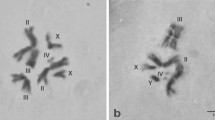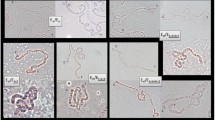Abstract
One modification of the primitive karyotype of the Drosophilidae is the absence of dot chromosomes. The origin of this modification is diverse. In some cases, the fate of the dot chromosomes can be directly inferred from cytogenetic analysis but in other cases a genetic or a combined molecular and cytogenetic analysis is needed, as occurs in Drosophila willistoni and Scaptodrosophila lebanonensis. We determined the location of four dot chromosome sequences in D. willistoni and S. lebanonensis using in situ hybridization. Drosophila melanogaster and D. virilis, which possess dot chromosomes, were used as a control. The in situ hybridization results show that dot chromosome genes of D. melanogaster and D. virilis are closely linked in chromosome 3 of D. willistoni and in chromosome X of S. lebanonensis. These results suggest an autosome--dot fusion in D. willistoni and an X--dot fusion in S. lebanonensis, two different paths in the evolution of dot chromosomes.
Similar content being viewed by others
References
Berendes HD, Thijssen WT (1971) Developmental changes in genome activity in Drosophila lebanonensis casteeli Pipkin. Chromosoma 33: 345–360.
Carson HL, Yoon JS (1982) Genetics and evolution of Hawaiian Drosophila. In: Ashburner M, Carson HL, Thompson Jr JN, eds. The Genetics and Biology of Drosophila 3b. London: Academic Press, pp 298–344.
Clayton FE, Wheeler MR (1975) A catalog of Drosophila metaphase chromosome configurations. In: King RC, ed. Handbook of Genetics 3. New York: Plenum Press, pp 471–512.
Clayton FE, Guest WC (1986) Overview of chromosomal evolution in the family Drosophilidae. In: Ashburner M, Carson HL, Thompson JN, eds. The Genetics and Biology of Drosophila 3e. London: Academic Press, pp 1–38.
Comerón JM, Aguadeé M (1996) Synonymous substitutions in the Xdh gene of Drosophila: Heterogeneous distribution along the coding region. Genetics 144: 1053–1062.
Dobzhansky T (1950) The chromosomes of Drosophila willistoni. J Hered 61: 156–158.
Dobzhansky T, Powell JR (1975) The willistoni group of sibling species of Drosophila. In: King RC, ed. Handbook of Genetics 3. New York: Plenum Press, pp 589–622.
Dombrádi V, Axton JM, Glover DM, Cohen PTW (1989) Cloning and chromosomal localization of Drosophila cDNA encoding the catalytic subunit of protein phosphatase 1α. High conservation between mammalian and insect sequences. Eur J Biochem 183: 603–610.
Dubreuil RR, Yu J (1994) Ankyrin and β-spectrin accumulate independently of α-spectrin in Drosophila. Proc Natl Acad Sci USA 91: 10285–10289.
Grimaldi DA (1990) A phylogenetic, revised classification of genera in the Drosophilidae (Diptera). Bull Am Mus Nat Hist 197: 1–139.
Gubenko IS, Evgen'ev MB (1984) Cytological and linkage maps of Drosophila virilis chromosomes. Genetica 65: 127–139.
Hamilton BJ, Mortin MA, Greenleaf AL (1993) Reverse genetics of Drosophila RNA polimerase II: identification and characterization of RpII140, the genomic locus for the second-largest subunit. Genetics 134: 517–529.
Krivshenko JD (1952) A cytogenetic study of the Y chromosome in Drosophila busckii. Genetics 37: 500–518.
Krivshenko JD (1959) New evidence for the homology of the short euchromatic elements of the X and Y chromosomes of Drosophila busckii with the microchromosome of Drosophila melanogaster. Genetics 44: 1027–1040.
Lakovaara S, Saura A (1972) Location of enzyme loci in chromosomes of Drosophila willistoni. Experientia 28: 355–356.
Lefevre G Jr (1976) A photographic representation and interpretation of the polytene chromosomes of D. melanogaster salivary glands. In: Ashburner M, Novitski E, eds. The Genetics and Biology of Drosophila 1a. New York: Academic Press, pp 31–66.
Lozovskaya ER, Petrov DA, Hartl DA (1993) A combined molecular and cytogenetic approach to genome evolution in Drosophila using large-fragment DNA cloning. Chromosoma 102: 253–266.
Lucchesi JC (1978) Gene dosage compensation and the evolution of sex chromosomes. Science 202: 711–716.
Mather W (1962) Patterns of chromosomal evolution in the immigrans group of Drosophila. Evolution 16: 20–26.
Montgomery E, Charlesworth B, Langley CH (1987) A test for the role of natural selection in the stabilization of transposable element copy number in a population of Drosophila melanogaster. Genet Res 49: 31–41.
Muller HJ (1940) Bearings of the Drosophila work on systematics. In: Huxley J, ed. New Systematics. Oxford: Clarendon Press, pp. 185–268.
Orenic TV, Slusarski DC, Kroll KL, Holmgren RA (1990) Cloning and characterization of the segment polarity gene cubitus interruptus Dominant of Drosophila. Genes Dev 4: 1053–1067.
Papaceit M, Juan E (1993) Chromosomal homologies between Drosophila lebanonensis and D. melanogaster determined by in situ hybridization. Chromosoma 102: 361–368.
Patterson JT, Stone WS (1952) Evolution in the genus Drosophila. New York: The Macmillan Company.
Quiring R, Walldorf U, Kloter U, Gehring WJ (1994) Homology of the eyeless gene of Drosophila to the small eye gene in mice and Aniridia in humans. Science 265: 785–789.
Stone WS (1955) Genetic and chromosomal variability in Drosophila. Cold Spring Harbor Symposia on Quantitative Biology 20: 256–270.
Sturtevant AH (1942) The classification of the genus Drosophila, with descriptions of nine new species. Univ Texas Pub 4213: 5–51.
Sturtevant AH, Novitski E (1941) The homologies of the chromosome elements in the genus Drosophila. Genetics 26: 517–541.
Whiting JH Jr, Pliley MD, Farmer JL, Jeffery DE (1989) In situ hybridization analysis of chromosomal homologies in Drosophila melanogaster and D. virilis. Genetics 122: 99–109.
Author information
Authors and Affiliations
Rights and permissions
About this article
Cite this article
Papaceit, M., Juan, E. Fate of dot chromosome genes in Drosophila willistoni and Scaptodrosophila lebanonensis determined by in situ hybridization. Chromosome Res 6, 49–54 (1998). https://doi.org/10.1023/A:1009218508672
Issue Date:
DOI: https://doi.org/10.1023/A:1009218508672




